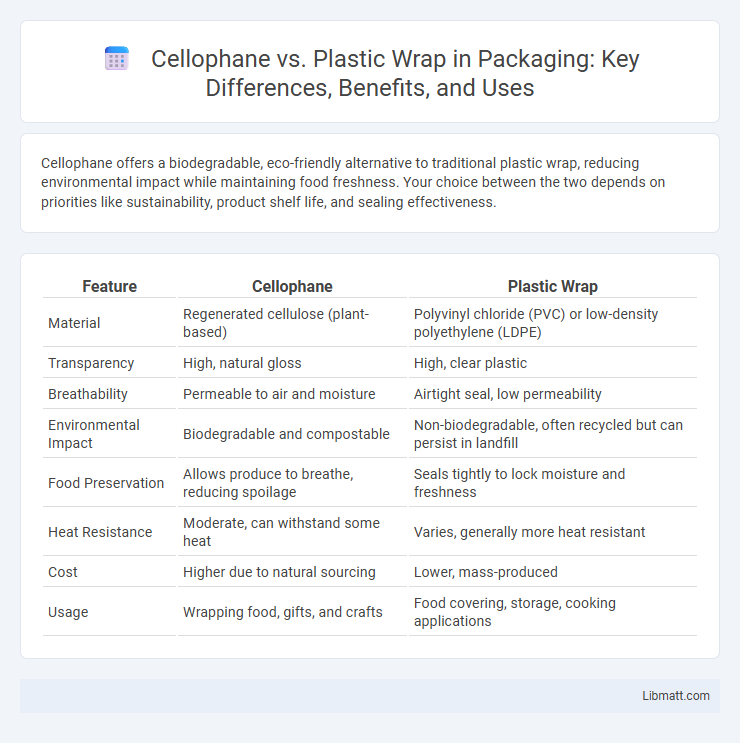Cellophane offers a biodegradable, eco-friendly alternative to traditional plastic wrap, reducing environmental impact while maintaining food freshness. Your choice between the two depends on priorities like sustainability, product shelf life, and sealing effectiveness.
Table of Comparison
| Feature | Cellophane | Plastic Wrap |
|---|---|---|
| Material | Regenerated cellulose (plant-based) | Polyvinyl chloride (PVC) or low-density polyethylene (LDPE) |
| Transparency | High, natural gloss | High, clear plastic |
| Breathability | Permeable to air and moisture | Airtight seal, low permeability |
| Environmental Impact | Biodegradable and compostable | Non-biodegradable, often recycled but can persist in landfill |
| Food Preservation | Allows produce to breathe, reducing spoilage | Seals tightly to lock moisture and freshness |
| Heat Resistance | Moderate, can withstand some heat | Varies, generally more heat resistant |
| Cost | Higher due to natural sourcing | Lower, mass-produced |
| Usage | Wrapping food, gifts, and crafts | Food covering, storage, cooking applications |
Introduction to Cellophane and Plastic Wrap
Cellophane is a thin, transparent film made from cellulose derived from wood pulp, offering biodegradability and breathability, making it ideal for packaging fresh produce and food items. Plastic wrap, typically composed of polyethylene or polyvinyl chloride (PVC), provides a flexible, airtight seal commonly used for preserving leftovers and preventing contamination. Both materials serve packaging purposes, but their composition and environmental impact differ significantly, influencing consumer choice and industry applications.
What is Cellophane?
Cellophane is a thin, transparent film made from regenerated cellulose, derived from natural sources such as wood pulp or cotton fibers. Unlike plastic wrap, which is typically made from petroleum-based polymers like polyethylene, cellophane is biodegradable and offers excellent moisture and aroma barrier properties. Your choice of packaging material can impact environmental sustainability, with cellophane being a more eco-friendly alternative to conventional plastic wraps.
What is Plastic Wrap?
Plastic wrap is a thin, transparent film made primarily from polyvinyl chloride (PVC) or low-density polyethylene (LDPE), designed for sealing food items to preserve freshness and prevent contamination. Its flexibility and clinginess allow it to conform tightly to containers or directly onto food surfaces, creating an airtight barrier that slows down spoilage and moisture loss. You can easily find plastic wrap in kitchens worldwide, where it serves as a practical solution for short-term food storage.
Key Differences Between Cellophane and Plastic Wrap
Cellophane is a biodegradable film made from cellulose, primarily derived from wood pulp or cotton, whereas plastic wrap is typically produced from petroleum-based polymers like polyvinyl chloride (PVC) or low-density polyethylene (LDPE). Cellophane offers superior breathability and moisture permeability, making it ideal for packaging fresh produce, while plastic wrap provides a tighter seal with better moisture and air barrier properties for preserving food freshness. The environmental impact of cellophane is significantly lower due to its compostable nature, contrasting with plastic wrap's long decomposition time and contribution to plastic pollution.
Environmental Impact: Cellophane vs Plastic Wrap
Cellophane, made from cellulose derived from wood pulp, is biodegradable and decomposes naturally within weeks, making it a more environmentally friendly option compared to plastic wrap, which is typically made from non-biodegradable petroleum-based polymers. Plastic wrap contributes significantly to pollution and landfill waste due to its long decomposition time and challenges in recycling. Your choice of cellophane over plastic wrap can reduce plastic pollution and support sustainable packaging practices.
Food Safety and Preservation Qualities
Cellophane is a biodegradable film made from cellulose that offers excellent breathability, reducing moisture buildup and preserving the freshness of fruits and vegetables longer than plastic wrap. Plastic wrap, typically made from polyethylene, creates an airtight seal that prevents moisture loss but can trap condensation, potentially leading to spoilage in some foods. In terms of food safety, cellophane is generally free from harmful chemicals like phthalates and PVC, while certain plastic wraps may contain additives that could migrate into food, especially when heated.
Cost Comparison: Cellophane vs Plastic Wrap
Plastic wrap is generally more cost-effective than cellophane, making it a preferred choice for everyday household use due to its lower price per roll and wider availability. Cellophane tends to be pricier because it is biodegradable and made from natural materials, which appeals to eco-conscious consumers willing to invest more in sustainable packaging. Comparing costs can help you decide based on budget constraints and environmental priorities.
Common Uses for Cellophane and Plastic Wrap
Cellophane is commonly used for packaging food items like bakery goods, candies, and fresh flowers, offering a biodegradable alternative with breathability that preserves freshness. Plastic wrap is widely employed for sealing leftovers, covering containers, and protecting food in refrigerators, providing airtight and moisture-resistant protection. Your choice depends on whether you prioritize eco-friendly packaging or superior cling and seal properties.
Which is Better: Cellophane or Plastic Wrap?
Cellophane offers superior biodegradability and breathability, making it ideal for wrapping fresh produce and preserving freshness naturally. Plastic wrap provides a tighter seal and better flexibility for airtight storage, reducing moisture loss longer in refrigerated or frozen items. Your choice depends on whether environmental impact or airtight preservation is your top priority.
Conclusion: Choosing the Right Wrap for Your Needs
Cellophane offers biodegradability and breathability, making it ideal for wrapping fresh produce and eco-conscious consumers. Plastic wrap provides superior airtight sealing and flexibility, suitable for preserving leftovers and preventing moisture loss. Selecting the right wrap depends on balancing environmental impact with functional requirements in food storage.
Cellophane vs plastic wrap Infographic

 libmatt.com
libmatt.com